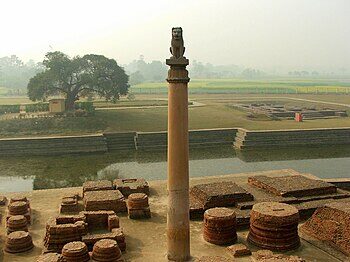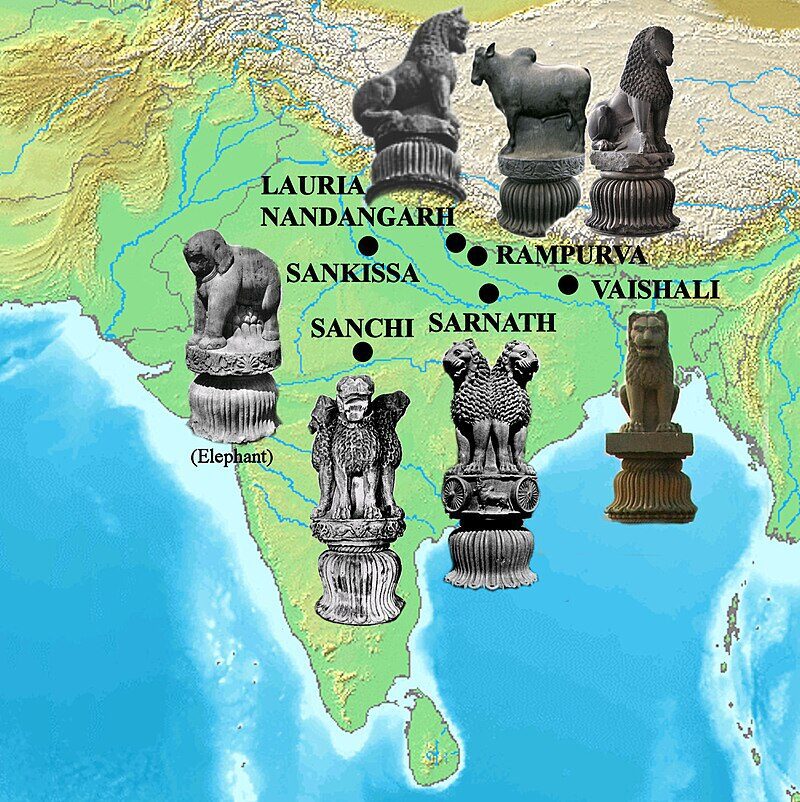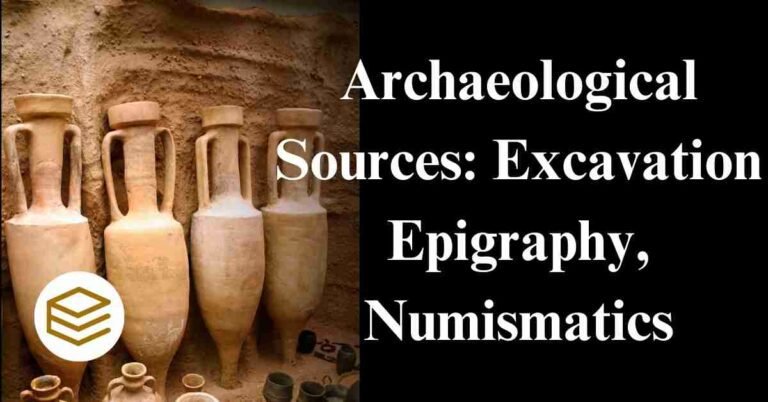December 8, 2025 5:30 pm
Introduction

The Ashokan pillars are monumental structures erected during the reign of Emperor Ashoka (268–232 BCE), the third ruler of the Mauryan Empire. These towering sandstone pillars, scattered across the Indian subcontinent, symbolize Ashoka’s commitment to Dhamma (righteousness) and reflect the zenith of Mauryan artistry, craftsmanship, and philosophical ideals. Inscriptions on the pillars disseminated Ashoka’s moral code, propagated Buddhist principles, and communicated with his vast empire.
Historical Context and Ashoka’s Vision
Pre-Ashokan Context
- The Mauryan Foundation:
- The Mauryan dynasty, established by Chandragupta Maurya in 321 BCE, marked the first large-scale empire in Indian history. The foundation of centralized administration and monumental architecture was laid during this period.
- Early Mauryan architecture primarily utilized wood, transitioning to stone only during Ashoka’s reign.
- Ashoka’s Early Reign:
- Ashoka, upon ascending the throne in 268 BCE, expanded the Mauryan Empire aggressively, reaching its zenith.
- The Kalinga War (circa 261 BCE) became a watershed moment, leading to Ashoka’s remorse and adoption of Buddhism. This war caused mass suffering, with an estimated 100,000 people killed and 150,000 displaced.
Ashoka’s Ideological Transformation
- Buddhism and Dhamma:
- Ashoka embraced Buddhism after Kalinga and championed the concept of Dhamma, emphasizing non-violence, tolerance, and ethical living.
- His patronage accelerated the spread of Buddhism across Asia, establishing it as a global religion.
- Role of Pillars in Propagation:
- The pillars acted as Dhamma Stambhas, spreading Ashoka’s edicts and moral principles to far-flung regions of his empire.
- Strategically placed in urban centers, trade routes, and Buddhist monasteries, they ensured maximum visibility and accessibility.
Construction and Engineering of Pillars
Materials and Techniques
- Stone Types:
- Chunar Sandstone: Characterized by a fine-grained buff texture, this stone was sourced near Varanasi.
- Mathura Sandstone: A reddish sandstone with white spots, sourced from the Mathura region.
- Monolithic Craftsmanship:
- Each pillar was carved from a single stone, showcasing the engineering prowess of Mauryan artisans.
- The shafts were lathe-turned for uniform tapering and polished to achieve the famous Mauryan sheen.
Transportation and Erection
- Transportation:
- The pillars, weighing up to 50 tons, were transported across hundreds of kilometers without modern machinery. Scholars hypothesize the use of sledges, rollers, and river routes.
- Erection Techniques:
- Pits were dug to anchor the pillars, ensuring stability.
- Metal dowels connected the shafts to the capitals, adding structural integrity.
Artistic Design
- Structural Elements:
- Shaft: Smooth and cylindrical, tapering upwards.
- Base: Usually buried, providing a stable foundation.
- Capital:
- Bell-shaped lotus design at the base.
- Abaci featuring motifs like rosettes, palmettes, or geese.
- Crowning animal sculptures, each symbolizing virtues or directions (e.g., lions for courage, elephants for wisdom).
- Polishing Techniques The signature Mauryan polish gave the pillars a mirror-like finish, achieved through advanced techniques of sanding and burnishing. This finish not only enhanced durability but also symbolized the purity of Ashoka’s Dhamma.
Symbolism in Ashokan Pillars
The Ashokan pillars are not merely architectural marvels; they carry profound symbolic meanings embedded in their design and inscriptions.
Animal Capitals
- Lions:
- Symbolize strength, courage, and guardianship.
- Represent the Buddha’s teachings as a “lion’s roar,” spreading across the land.
- Elephants:
- Denote Buddha’s conception and wisdom.
- Associated with the spreading of Buddhist doctrines, as seen in the Sankissa pillar.
- Bulls:
- Represent fertility, perseverance, and strength.
- Reflect the agrarian society that thrived under Ashoka’s rule.
- Horses:
- Symbolize mobility and the spread of Dhamma across regions.
- Often linked to Buddha’s renunciation and journey towards enlightenment.
Lotus Base
- Represents purity and spiritual awakening.
- Symbolizes the emergence of divine wisdom from the mire of worldly life.
Circular Abacus
- Depictions of geese (hamsa), rosettes, and flame palmettes reflect the interconnectedness of spiritual and material realms.
- Often include wheels, symbolizing the Dharma Chakra, a representation of the Buddha’s teachings.
Inscriptions on Ashokan Pillars
The inscriptions on Ashokan pillars form the earliest extensive body of Indian epigraphy, revealing Ashoka’s administrative and moral philosophy.
Languages and Scripts of inscriptions
- Languages:
- Predominantly in Prakrit, the lingua franca of the common people.
- Some inscriptions in Greek and Aramaic, reflecting Ashoka’s multi-ethnic empire.
- Scripts:
- Most inscriptions were etched in Brahmi, the precursor to many modern Indian scripts.
- Kharosthi, used in the northwestern regions.
Types of Edicts
- Minor Pillar Edicts:
- Personal reflections of Ashoka, emphasizing humility and his dedication to Dhamma.
- Example: The Schism Edicts warn against divisions within the Buddhist Sangha.
- Major Pillar Edicts:
- Policy-oriented, detailing welfare measures, religious tolerance, and ethical governance.
- Example: Pillar Edict VII discusses the duties of officials and Ashoka’s aspirations for harmony.
Edicts of Ashoka
Ashokan inscriptions, meticulously engraved on the pillars, are key to understanding his administration, philosophy, and vision. These inscriptions are divided into Minor Pillar Edicts and Major Pillar Edicts, each addressing distinct aspects of governance and Dhamma.
Minor Pillar Edicts
The Minor Pillar Edicts focus on specific messages, often addressing the Buddhist Sangha. Below are significant examples:
- Sarnath Schism Edict:
- Warns monks and nuns against creating divisions within the Sangha.
- Emphasizes Ashoka’s role as a guardian of Buddhist unity.
- Kosambi (Allahabad) Queen’s Edict:
- Mentions charitable activities and social welfare initiatives by Ashoka’s queen.
- Highlights Ashoka’s personal involvement in promoting Dhamma through royal patronage.
- Nigali Sagar (Nepal) Inscription:
- Commemorates Ashoka’s visit to the Konakarnana Stupa.
- Marks the site’s significance as a Buddhist pilgrimage center.
- Lumbini Inscription:
- Celebrates Ashoka’s visit to Buddha’s birthplace.
- Declares reduced taxes and special privileges for the village, reflecting Ashoka’s patronage of Buddhist heritage.
Major Pillar Edicts
The Major Pillar Edicts outline broader governance principles and ethical codes. They were intended to guide both officials and citizens. Key edicts include:
- Pillar Edict I:
- Focuses on the protection of animals and the importance of moral conduct.
- Prohibits animal sacrifice and outlines humane treatment of living beings.
- Pillar Edict II:
- Defines Dhamma as a code of ethical living, encompassing truthfulness, compassion, and self-restraint.
- Advocates for religious tolerance and mutual respect among communities.
- Pillar Edict III:
- Encourages abstention from anger, cruelty, and arrogance.
- Highlights the need for emotional control as a pillar of ethical behavior.
- Pillar Edict IV:
- Outlines the responsibilities of government officials in promoting Dhamma.
- Emphasizes administrative accountability and citizen welfare.
- Pillar Edict V:
- Lists animals that should not be killed under any circumstances.
- Reflects Ashoka’s progressive animal welfare policies and deep empathy for all life forms.
- Pillar Edict VI:
- Describes Ashoka’s efforts to disseminate Dhamma through inscriptions and royal emissaries.
- Encourages all sects to strive for self-control and purity of mind.
- Pillar Edict VII:
- Summarizes Ashoka’s commitment to Dhamma as the foundation of his rule.
- Stresses the role of ethical governance in fostering societal harmony.
Geographical Spread and Notable Pillars
The Ashokan pillars are dispersed across modern-day India, Nepal, and Pakistan. Each location reflects strategic intent and cultural significance.
- Sarnath (Uttar Pradesh):
- The most iconic pillar, crowned with the Lion Capital, symbolizing India’s national emblem.
- Located near the site of Buddha’s first sermon.
- Vaishali (Bihar):
- Features a single lion capital facing north, marking Buddha’s last sermon.
- Rampurva (Bihar):
- Two pillars, one with a lion and another with a bull capital, exemplify Hellenistic influence.
- Delhi-Topra and Delhi-Meerut:
- Relocated by Sultan Firuz Shah Tughlaq to Delhi in the 14th century.
- Feature inscriptions emphasizing governance and public welfare.
- Lauriya Nandangarh (Bihar):
- A single lion capital with six edicts, focusing on moral principles.

Cultural and Artistic Influences on Ashokan Pillars
Foreign Influences
- Achaemenid (Persian):
- Use of monolithic columns echoes Persian practices.
- Decorative elements like palmettes and rosettes show stylistic similarities.
- Hellenistic (Greek):
- Realistic depictions of animals, particularly lions, reflect Hellenistic realism.
- Abaci designs featuring bead-and-reel patterns and honeysuckles highlight Greek aesthetics.
Indigenous Innovations
- Lotus Motif:
- A uniquely Indian element, symbolizing purity and enlightenment.
- Integration of Dhamma:
- The blending of artistic forms with ethical messages demonstrates Ashoka’s visionary approach.
Rediscovery and Preservation
Colonial Rediscovery
- The pillars were brought to scholarly attention during British rule.
- James Prinsep’s decipherment of Brahmi script in 1837 unlocked the historical significance of Ashoka’s inscriptions.
Preservation Efforts
- Museums:
- Capitals like the Sarnath Lion are housed in museums for protection.
- Legislation:
- The Archaeological Survey of India safeguards these monuments under the Ancient Monuments and Archaeological Sites and Remains Act.
Major Ashokan Pillars
Each of the surviving Ashokan pillars tells a unique story, blending architectural finesse, inscriptions, and historical significance. Below are detailed case studies of prominent pillars, highlighting their construction, inscriptions, and legacy.
1. Sarnath Pillar (Uttar Pradesh)
Significance:
- Located near the Deer Park, where Buddha delivered his first sermon.
- Represents the dissemination of the Buddha’s teachings, making it a site of monumental spiritual significance.
Architectural Features:
- Lion Capital:
- Four lions seated back-to-back on a circular abacus.
- The abacus features alternating depictions of the Dharma Chakra and four animals: a lion, an elephant, a horse, and a bull.
- The animals symbolize cardinal directions and virtues associated with the Buddha’s life.
- The capital likely supported a large stone Dharma Chakra wheel.
- Shaft:
- Made of polished Chunar sandstone, tapering upwards.
- The surface’s lustrous finish exemplifies Mauryan craftsmanship.
Inscriptions:
- Schism Edict: Warns monks and nuns against causing divisions within the Buddhist Sangha, underscoring Ashoka’s concern for religious harmony.
Legacy:
- The Lion Capital became India’s national emblem in 1950, embodying principles of justice and strength.
- The Ashoka Chakra, featured on the Indian flag, draws inspiration from this pillar.
2. Vaishali Pillar (Bihar)
Significance:
- Marks the site where Buddha preached his last sermon and announced his imminent death (Mahaparinirvana).
- Highlights the region’s historical importance as a center of Buddhist learning.
Architectural Features:
- Lion Capital:
- A single lion facing north, symbolizing Buddha’s journey towards enlightenment.
- Abacus:
- Features a plain design, lacking the intricate carvings seen in other capitals.
- Shaft:
- Smooth and monolithic, made of Chunar sandstone.
Inscriptions:
- The pillar lacks Ashokan edicts but is associated with the Buddhist Sangha.
Legacy:
- The Vaishali pillar stands as a testament to Ashoka’s reverence for sites associated with Buddha’s life.
- Attracts pilgrims and scholars studying early Buddhist art and architecture.
3. Rampurva Pillars (Bihar)
Significance:
- Two distinct pillars, located near the Nepal border, highlight Ashoka’s strategic placement of monuments along trade routes.
Architectural Features:
- Lion Capital:
- Features a majestic lion seated on a circular abacus.
- The abacus is adorned with floral patterns, including honeysuckles and rosettes.
- Bull Capital:
- The bull is depicted with realistic musculature and gentle expression, reflecting Hellenistic influence.
- Shafts:
- Both shafts are monolithic and polished to a high sheen.
Inscriptions:
- Pillar Edicts I–VI outline ethical conduct, animal welfare, and administrative duties.
Legacy:
- The Rampurva bull capital is now housed in Rashtrapati Bhavan, New Delhi, showcasing Ashokan art’s influence on Indian identity.
4. Lauriya-Nandangarh Pillar (Bihar)
Significance:
- Located along the ancient royal highway connecting Pataliputra to Nepal, emphasizing Ashoka’s administrative foresight.
Architectural Features:
- Lion Capital:
- A single lion stands on a circular abacus.
- The lion’s posture exudes strength and vigilance.
- Shaft:
- The monolithic pillar features six of Ashoka’s edicts.
Inscriptions:
- Focus on ethical governance, non-violence, and respect for all life forms.
- Emphasizes Ashoka’s aspiration for a harmonious society.
Legacy:
- The pillar remains a vital source for understanding Ashoka’s administrative and moral principles.
5. Allahabad Pillar (Uttar Pradesh)
Significance:
- Originally erected in Kausambi, it was later relocated to Allahabad.
- The pillar records three distinct periods of Indian history: Ashokan, Gupta, and Mughal.
Architectural Features:
- Abacus:
- Features floral motifs resembling those of the Rampurva pillars.
- Shaft:
- Monolithic and polished sandstone.
Inscriptions:
- Ashokan Edicts:
- Pillar Edicts I–VI highlight principles of Dhamma and governance.
- Gupta Inscription:
- Records the conquests of Samudragupta, providing insight into Gupta administration.
- Mughal Inscription:
- Jahangir’s Persian inscription commemorates his reign.
Legacy:
- The Allahabad pillar exemplifies the continuity of historical narratives across dynasties.
- Represents a confluence of Mauryan, Gupta, and Mughal cultural influences.
Cultural Symbolism and Religious Impact
Dhamma and Ethical Governance
- The pillars encapsulate Ashoka’s philosophy of Dhamma, promoting universal values like non-violence, compassion, and justice.
- Served as tangible reminders of Ashoka’s moral governance, fostering accountability among officials.
Buddhism’s Spread
- The pillars, inscribed with Ashoka’s edicts, became tools for spreading Buddhism across the subcontinent and beyond.
- Reinforced the sanctity of Buddhist pilgrimage sites, solidifying their status as centers of learning.
Artistic Syncretism
- The fusion of indigenous and foreign elements in the pillars symbolizes India’s openness to external influences.
- The depiction of animals like lions, elephants, and bulls reflects both spiritual and secular values.
Architectural Influence on Subsequent Eras
Gupta and Post-Gupta Periods
- The Gupta dynasty, known for its golden age of art, drew inspiration from Ashokan pillars in designing temple columns and stupas.
- Examples include the iron pillar of Delhi and the Vishnu Stambha at Khajuraho.
Medieval Period
- The Ashokan legacy continued to inspire Indo-Islamic architecture, evident in the minarets and commemorative pillars of the Delhi Sultanate.
Modern Times
- The national flag of India, featuring the Ashoka Chakra, underscores the enduring legacy of the pillars.
- Contemporary architectural projects often draw inspiration from the simplicity and symbolism of Ashokan designs.
Challenges in Preservation and Conservation
Threats to the Pillars
- Natural Erosion:
- Weathering has caused significant damage to inscriptions and capitals.
- Human Vandalism:
- Historical accounts describe deliberate destruction by invaders and iconoclasts.
Preservation Efforts
- Role of Archaeological Institutions:
- The Archaeological Survey of India (ASI) oversees the maintenance and restoration of Ashokan pillars.
- Museum Relocation:
- Capitals like those from Sarnath and Rampurva are housed in museums to protect them from environmental damage.
Ashokan Pillars as Global Symbols
Universal Values
- The inscriptions promote ideals like non-violence, tolerance, and respect for diversity, resonating with contemporary global ethics.
Cultural Bridges
- The pillars symbolize the interconnectedness of civilizations, blending Indian, Persian, and Hellenistic influences.
Tourism and Education
- The pillars attract scholars, historians, and tourists, serving as educational tools and cultural landmarks.






[…] Ashokan Pillars: Mauryan Art and Philosophy […]